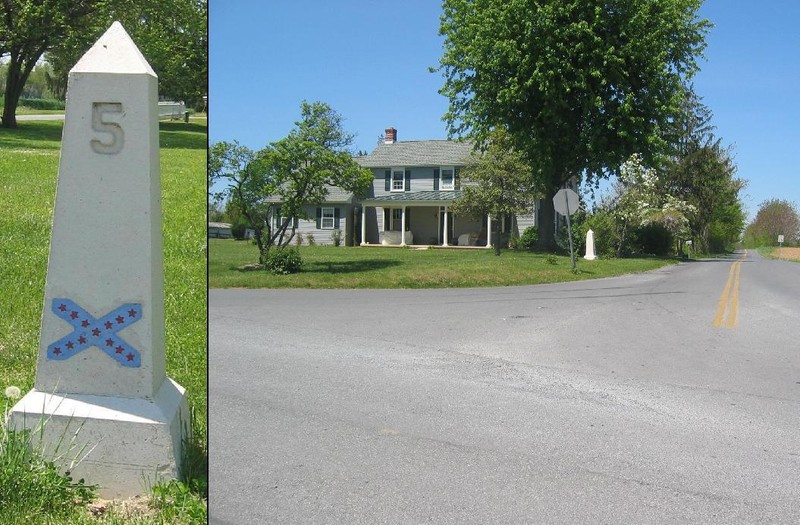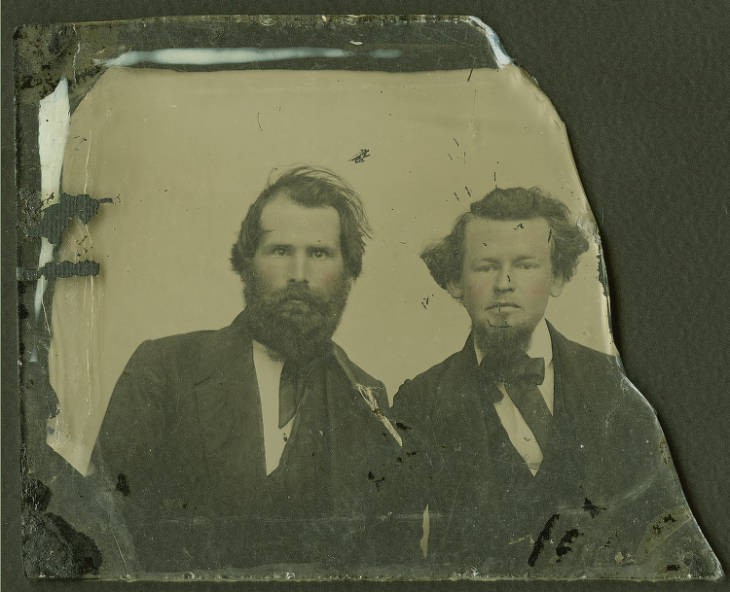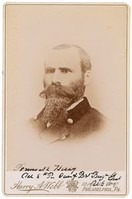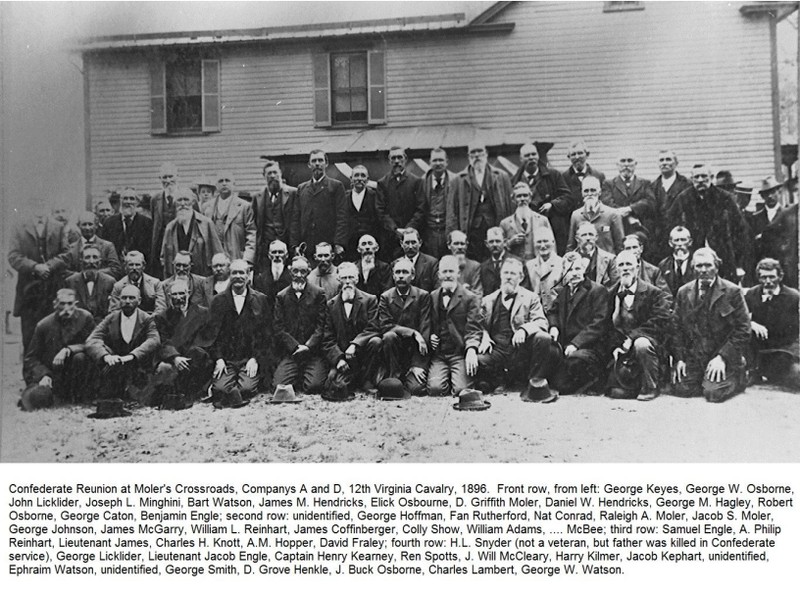UCV Civil War Military Operations Marker #5: Skirmish at Moler's Cross Roads, July 16, 1863
Introduction
Text-to-speech Audio
Images

Pennock Huey (left) and John T. Piggott, Jr.

Col. Pennock Huey

Confederate Reunion at Moler's Crossroads, Companies A & D, 12th Virginia Cavalry, 1896

Backstory and Context
Text-to-speech Audio
In the aftermath of the Battle of Gettysburg (July 1-3, 1863), Confederate General Robert E. Lee’s Army of Northern Virginia began their retreat from Pennsylvania on July 4. The Confederate force aimed for Williamsport, Maryland where they could cross the Potomac River into West Virginia. A flooded Potomac stalled Lee’s crossing and led to short face-off between the armies before Lee could cross his army at Williamsport and Falling Waters. During Union General Meade’s pursuit of Lee to the Williamsport lines, on July 7 Union Brigadier General Henry M. Naglee ordered a detachment to secure Harpers Ferry to prevent the Confederates from taking it.
After securing the Potomac River crossing at Harpers Ferry and Maryland Heights, the Union forces established picket lines around the roads to Harpers Ferry on the West Virginia side. On July 14, 1863 Major Charles Farnsworth and 50 men of the 1st Connecticut Cavalry were on picket on the roads near Harpers Ferry and Halltown. They engaged with Confederate pickets from Company B, 12th Virginia Cavalry under Colonel Asher W. Harman, numbering 6-30 depending on the account. In the initial skirmish, the Union force under Farnsworth was successful in capturing Colonel Harman and several of the pickets with him. Those few Confederate men not captured escaped to warn their nearby comrades, and as Farnsworth continued to pursue the pickets he found his men surrounded by Confederate reinforcements of 200 troopers under Lieutenant Colonel Massie. In the second skirmish Farnsworth and 24 cavalrymen were captured and several of their original prisoners released. After Farnsworth’s capture, Captain Eratus Blakeslee took command and fell back to the Union positions at Harpers Ferry with Harman and 6 others as prisoners.
The following day, July 15, 1863, a force of cavalry under Colonel Charles H. Smith of the 1st Maine Cavalry again advanced from Harpers Ferry to Halltown. They approached Charles Town and drove the Confederate pickets into the town. After a few hours of skirmishing outside Charles Town, Smith’s forces retreated to Halltown. Since they could not take Charles Town, Smith left the 13th Pennsylvania Cavalry as pickets there and took the 1st Maine Cavalry to Shepherdstown.
On July 16th, Smith’s force left Shepherdstown and advanced towards Kearneysville. While on the road Smith received reports that the Union pickets at Kearneysville were engaged with Confederates and falling back. When Smith approached the fight at Kearneysville he was not able to reinforce the pickets and determined that the Confederate force (under Brigadier General Fitzhugh Lee and Col. John Chambliss) outnumbered his. Smith’s Union cavalry fought dismounted due to the terrain with some artillery support, but the Confederates were able to take control of the high ground on a nearby ridge and bring up heavy artillery. Eventually Smith was forced to withdraw and they retreated towards Shepherdstown and stopped at Butler’s Woods. There they held off the Confederates until dark and after midnight Smith fell back to Harpers Ferry.
As Smith was engaged at Kearneysville, the Eighth Pennsylvania Cavalry under Colonel Pennock Huey was ordered to move and reinforce him. Huey decided to travel through Moler’s Cross Roads to reach Smith. Confederate scouts saw Huey’s troop movements and Major John L. Knott dispatched Company D, 12th Virginia Cavalry to stop them. Company D halted Huey’s force for three hours, effectively preventing them from reinforcing Smith at Kearneysville. The Union troops finally pushed past the 12th Virginia Cavalry and advanced to Kearneysville, but by the time Huey got there Smith had already been driven back to Butler’s Woods.
About the Monuments:
This series of monuments and accompanying tour pamphlet were part of an initiative from the Jefferson County Camp, United Confederate Veterans to commemorate the 50th anniversary of the Civil War. In 1910 Col. R. Preston Chew and the Jefferson County UCV raised the funds to place 25 concrete obelisks in Jefferson County to mark locations of engagement or other significant events. The following year the Camp published a pamphlet to accompany the obelisks and give more information about each location. This was Military Operations in Jefferson County, Virginia (Now West Virginia), 1861-1865 published in 1911. The pamphlet has been reprinted several times by the Henry Kyd Douglas Camp, No. 199 of the Sons of Confederate Veterans. Because the monuments and accompanying pamphlet were done by Confederate veterans it is likely that the locations and descriptions are biased towards or favor the Confederate view and experience of the war.
Original Text from the 1911 Pamphlet:
"Markers Two, Five and Seven
Butler’s Woods, Moler’s Cross Roads, and Uvilla
After the Gettysburg Campaign, with Lee back in Virginia and Harpers Ferry in the hands of the enemy, the situation in Jefferson County was about as follows:—The enemy’s pickets extended about 2 miles from Harpers Ferry, with signal and spy stations on Maryland Heights. Any movement of troops in day time could be seen by them. Even many of the picketposts were under their observation. The Shenandoah River was high,—hardly fordable. Lee’s army was in Jefferson and Berkeley Counties until after the middle of the month. The Potomac and Shenandoah Rivers were carefully picketed, and the army uncertain what the next move would be. On the Sixteenth, the Federals, crossing at Shepherdstown and driving in the pickets, advanced a large force of cavalry as far as Kearneysville. Here Fitz Lee and Chambliss’ brigades of cavalry confronted them and steadily drove them back. The federals were amply supplied with artillery, and at every favorable position, made stubborn resistance. Late in the evening, Stuart came on the field and took command, having ordered General Jenkins, with his brigade of cavalry from near Martinsburg to his assistance, who arrived later in the evening.
The enemy, having fallen back to Butler’s woods, made a final stand. The cavalry could not well operate, and so both sides dismounted their men and fought until dark. The Confederates remained on the field, expecting to renew the engagement in the morning, but the enemy moved off in the night.
There is not official account of the losses on either side. Colonel Drake, of the first Virginia Cavalry, was mortally wounded, and died that night at Mr. Marshall’s. About 40 feet from Marker No. 2, measuring west, is the place where he was shot. He was an able officer.
This movement of the enemy had been made to ascertain Lee’s position, but failed. This force was to have been supported by a brigade from Harpers Ferry, but they failed to arrive on time, as will be shown. Company D, of the Twelfth Virginia Cavalry, was picketing from near Shepherdstown to Engle’s Hill; and when the advance was made, they stayed within the enemy’s lines to operate. A courier was captured at Uvilla on the evening of the fifteenth, and sufficient information obtained to justify our watching this road.
Early on the morning of the sixteenth, Captain Kearney took position in the timber adjoining the Uvilla store, put a picket in either direction, and awaited events. It was not long until a squad appeared. They were taken in. The company would divide, and charge front and rear. This was continued until thirty-three prisoners, their horses and equipments, and the General’s head-quarter’s wagon with his extra clothing, camp fixtures, and bedding and two fine horses and harness, and servant were captured. Several escaped and gave the alarm. Marker No. 7, on the hill north of the Uvilla store, is where most of the captures were made.
Major Knott, joining the company at this time, sent the prisoners back to safety, and moved the company to Moler’s Cross Roads, two and one-half miles east of Uvilla. When they neared the place, they saw the advance guard of some force. They charged and captured one. The others ran into their column, closely followed by our company. They were over the hill and could not be seen. The company wheeled about and exchanged some shots and retired. It was a brigade of cavalry with artillery on their way to reinforce their forces at Shepherdstown. They, supposing that a heavy force was in their front, placed their artillery in position, threw out skirmishers, put their squadrons in line of battle and awaited developments. Full three hours time was lost. Every citizen that happened along was held by them until near midnight.
They finally moved on, and joined forces near Shepherdstown; but too late. This timely check of this brigade for three hours undoubtedly saved the day on the pike at Butler’s woods. Our forces were very many less than theirs.
Marker No. 5 at Moler’s Cross Roads, is a few hundred yards west of where the brigade was checked."
Cite This Entry
Historic Landmarks Commission, Jefferson County and Kathleen Thompson. "UCV Civil War Military Operations Marker #5: Skirmish at Moler's Cross Roads, July 16, 1863." Clio: Your Guide to History. February 17, 2021. Accessed March 24, 2025. https://theclio.com/entry/77052
Sources
Bushong, Millard Kessler. A History of Jefferson County, West Virginia. Charles Town, WV: Jefferson Publishing Company, 1941.
Engle, Stephen Douglas. Thunder in the Hills: Military Operations in Jefferson County, West Virginia, During the American Civil War. Charleston, WV: Mountain State Press, 1989.
Hawks, Steve A. “1st Virginia Cavalry Regiment.” The Civil War in the East. Accessed January 22, 2021. https://civilwarintheeast.com/confederate-regiments/virginia/1st-virginia-cavalry/
Hearn, Chester G. Six Years of Hell: Harpers Ferry During the Civil War. Baton Rouge: Louisiana State University Press, 1996.
Military Operations in Jefferson County Virginia (and West Va.) 1861-1865. Published by Authority of Jefferson County Camp U.C.V. Farmers Advocate Print, 1911. Accessed January 20, 2021. https://babel.hathitrust.org/cgi/pt?id=uc2.ark:/13960/t4vh5gp6c&view=1up&seq=5.
“R. E. Lee to General S. Cooper, Adjutant and Inspector General, Richmond, Va.” Official Records of the War of the Rebellion Series 1, Volume 27, part 2, p. 303. Timeline of West Virginia: Civil War and Statehood, July 14, 1863. Child of the Rebellion: An Archives and History Sesquicentennial Project. West Virginia Department of Arts, Culture and History. Accessed January 22, 2021. http://www.wvculture.org/history/sesquicentennial/18630716b.html.
“Report of Brig. Gen. Henry M. Naglee, U.S. Army, of skirmish near Harper’s Ferry, W. Va.” And “Report of Capt. Erastus Blakeslee, First Connecticut Cavalry, of skirmish near Harper’s Ferry, W. Va.” Official Records of the War of the Rebellion Series 1, Volume 27, part 2, pp. 204-205. Timeline of West Virginia: Civil War and Statehood, July 14, 1863. Child of the Rebellion: An Archives and History Sesquicentennial Project. West Virginia Department of Arts, Culture and History. Accessed January 22, 2021. http://www.wvculture.org/history/sesquicentennial/18630714b.html0
"Pennock Huey and John T. Piggott, Jr., daguerreotype." Digital Maryland. Accessed January 22, 2021. https://collections.digitalmaryland.org/digital/collection/mcw/id/358/.
"Photos of Brevet Brig. General Pennock Huey (USA)." Geni. Accessed January 22, 2021. https://www.geni.com/photo/view/6000000013216175079?album_type=photos_of_me&photo_id=6000000024261415916.
"Daniel Moler--Stories." Fold3. Accessed January 22, 2021. https://www.fold3.com/page/637555213/daniel-moler/stories. Photo: http://184.12.255.121/Portals/0/Wills/3383b.PDF.

